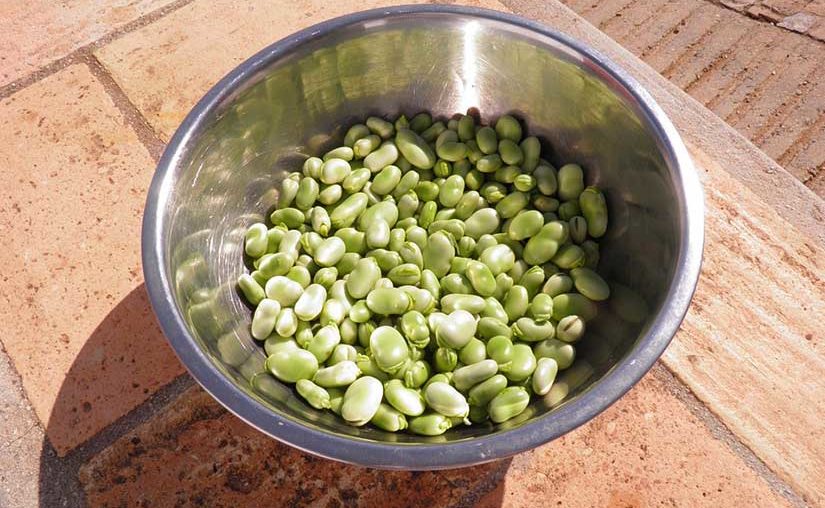The bean is a legume particularly rich in proteins, vitamins and minerals. And it is as raw as cooked, and it can easily be frozen. Yet, it remains quite rare on the stalls. To enjoy its benefits and its flavor, the ideal is to cultivate it yourself!
When to sow the beans?
The bean is traditionally sown mid-March to the end of April. If you opt for a hot sowing – in other words in a greenhouse – you can start as early as February. Think about staggering your seedlings, spacing them by 15 days: this will allow you to extend the production period!
Although the bean is associated with summer, this annual plant is able to withstand a mild and wet winter. Once raised, it is even able to resist weak frosts. In the south of France or in regions with an oceanic climate like Brittany, it is therefore possible to carry out a second sowing in November, in order to benefit from a harvest at the end of the winter.
Hot or in place, think about taking a look at the lunar calendar, to plant in the rising moon!
Which varieties to choose?
The bean – its real name Vicia Fava – produces pods that can contain 4 to 10 seeds whose size varies according to the variety. The choice is vast, and it depends mainly on the climate and your culinary tastes.
The swamp bean
The swamp bean is considered to be one of the oldest cultures of humanity. It was grown well before beans and potatoes, usually near rivers. It is still the most widespread in France and North America. The swamp bean produces seeds that are eaten both fresh and cooked, and can be dried once fully grown. We distinguish Windsor – with round seeds – from the Longpodwhich produces a longer pod and smaller seeds of more stretched form.
The Muchamiels
This family includes several early varieties, identifiable by their light green pods. The most widespread remains the bean of Aguadulce, whose very long pod (up to 35 cm!) is home to 8 to 10 fleshy seeds. Gourmets who prefer exclusively fresh beans prefer the early Aquitaine. Although its pods are of a more modest size, they are nonetheless generously lined with tasty seeds.
The Red Epicure
This variety native to England is distinguished by its original color. Its light pink pod has a beautiful purple color when ripe, and produces red seeds. If the Red Epicure is superb, it is above all appreciated for its taste qualities! This variety is particularly suitable for fall seeding.
What to do before sowing the beans?
The beans require a good exposure : choose a sunny plot. Vicia Fava is a legume, which fixes the nitrogen contained in the air. It is therefore not necessary to amend the land. On the other hand, she will appreciate a very soft ground. Work the plot with the fork to loosen the ground on at least 30 cm. Grab and then level with the rake. You can also incorporate a little potash 15 days before sowing. The main tip for successful sowing, however, is the seeds: soak them in water for 24 hours before planting.
How to sow them?
Sowing in place
- Draw furrows 5 cm deep spaced 40 cm apart;
- Arrange seeds spaced 12 to 15 cm apart;
- Rebuild tightly;
- Water generously.
It should be noted that seedlings can also be made in 3 or 4-seeded pox, spaced 30 to 35 cm apart.
When seed germs and seedlings appear, be sure to aerate the soil, by hoeing and removing weeds. For sowing in autumn, it is recommended to install a wintering veil.
Hot sowing
Vicia Fava rather, a seedling in place, but she knows how to accommodate a hot sowing. We will use individual buckets:
- Fill the pits with potting soil;
- Deposit one seed per bucket, placing it 5 cm deep;
- Cover and tamp well.
The buckets must be placed in a warm environment (20/21 ° C). To maximize your chances of success, you can cover the seedlings with a plastic sheet. Wait until the plants reach 10 to 12 cm high to put them in place. Make rows spaced 30 cm apart, and respect 25 cm between two plants.
Where to plant the beans?
Vicia Fava particularly appreciates the neighborhood of the tomato. She also likes squash, cucumber, eggplant, zucchini and strawberry. On the other hand, she does not appreciate the company of garlic, onion, leeks and chives.
In order to prevent the spread of diseases in the kitchen garden, it is recommended to carry out a crop rotation over 3 years. After the beans, the ideal will be to grow leafy vegetables (cabbage or salad) the second year, then bulb vegetables such as onion 3th year.
How to maintain them?
The beans are not very demanding, and they are content with some basic care:
- Butter the plants twice: at 10 cm then at 30 cm height;
- Regularly biner the earth to keep it loose;
- Weed regularly.
It should be noted that the higher varieties need to be staked.
How to water the beans?
If the beans like the sun, they do not like drought. It is therefore essential to offer them a daily watering. It is also interesting to mulch your plants: not only will this optimize watering, but it will also limit the proliferation of weeds.
Harvesting beans: when and how?
The beans are harvested about 3 months after sowing. The pods are harvested before they reach full maturity when the seeds are visible. If you wish to obtain dry beans, however, it will be necessary to wait until the pods begin to blacken to harvest them.
If the beans are rare on the stalls, it is because they do not keep more than 2 to 3 days. To fully enjoy their flavor, the ideal is to harvest them as and when your needs. If the production is too important, you can freeze your beans. To do this, all you have to do is remove the skin that covers the grains and place them in the freezer, where they will keep for a year.
Diseases of beans and what to do?
Aphids are the main scourge of beans. When they invest the plants, they feed on their sap, producing in passing a large amount of sooty mold. This substance blackens the leaves, which should alert you. Without your intervention, the aphids will stop the development of the plants.
Aphids have the particularity of colonizing the top of the stem of the beans. We will take care to pinch the rod between the 6th and the 10th flower to prevent their appearance.
In case of massive invasion, you can treat your plants with a non-toxic mixture: dilute 30 to 35 gr of black soap in a 1L of water, add 1 tablespoon of vegetable oil, and spray this mixture on the plants. This treatment can be repeated regularly, until the disappearance of insects.
Even more plantations:








